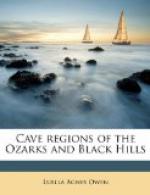The disappointment of not having seen this cave during the summer visit to the Hills grew as the weeks passed, and a request that the owner should send a description was answered with an assurance that it was impossible. Therefore, on Friday, November 13th, 1896, with a small nephew, Herbert A. Owen, Jr., for company, the trip was undertaken a second time to complete the unfinished mission.
The first glimpse of the Hills is at Edgemont in the early morning, but the train makes its way to the north through the heart of the uplift, twisting about the curves of the hills and clinging to the sides of a beautiful canon whose high walls give way here and there to fine slopes densely covered with forests of pine and spruce. These look black in the distance and suggested the name of Black Hills to the Indians, who always have a reason for the names they give even to their children.
There are great tracts where fire has killed part or all of the timber but left much of it standing, while in other places nature has defied the power of fire and the hills are re-clothed with young trees. A recent storm had further beautified the region with a few inches of snow, but as the day advanced a chinook began to blow so that when Deadwood was reached, soon after noon, only the northern exposures retained an appearance of winter.
Deadwood is a most peculiar little city and very attractive in its peculiarity, being crowded snugly into a depression between a number of steep pine-wooded hills, which gives an appearance suggestive of a bird’s nest securely located among the forks of a branching tree, and as is the case in a nest, business is chiefly transacted at the lowest depth of the enclosure. As the busy center of a great gold-mining region, the metropolis of the Hills, and the outgrowth of an exciting historical past, it claims and receives interesting attention. And while the whole Black Hills region is still distinctly a man’s country, it is called woman’s paradise, and surely nowhere else are the daughters of Eve received with a more gracious courtesy or surrounded by an equally unobtrusive protecting care.
[Illustration: Approaching Deadwood. Page 176.]
The streets leading up to the residences lack very little of standing on end, and the houses appear to have been hung in place by means of hooks and wire cord like pictures on a wall. The smelter has no reception day but admits visitors as if their pleasure were a guarantee of profit.
The finest scenery in the Hills is said to be that of the Spearfish Canon, north of Deadwood, and the finest of that at the Falls, but this may be doubtful as other points are very beautiful, especially where the Burlington & Missouri Road requires a distance of seven miles to climb the canon wall.
Piedmont being the nearest town to Crystal Cave, we took the early evening train on the Elk Horn Road and soon were located, and shocked to learn that the proprietor of the cave had started several days before to drive to Wind Cave for specimens. The cave was closed and no one there. The trip had been taken for the one purpose of exploring Crystal Cave, and a letter sent in advance to announce our coming, but the train carrying it was an hour late so he drove off without the mail.




